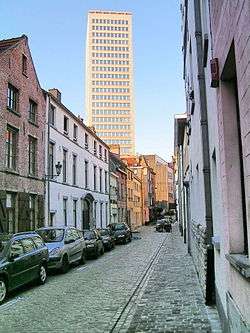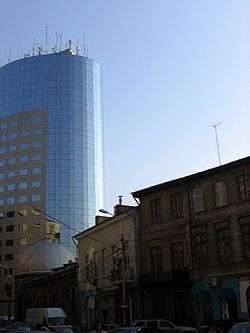Brusselization
In urban planning, Brusselization (UK and US) or Brusselisation (UK variant) (French: bruxellisation, Dutch: verbrusseling) is "the indiscriminate and careless introduction of modern high-rise buildings into gentrified neighbourhoods" and has become a byword for "haphazard urban development and redevelopment".[1][2]

The notion applies to anywhere whose development follows the pattern of the uncontrolled development of Brussels in the 1960s and 1970s, that resulted from a lack of zoning regulations and the city authorities' laissez-faire approach to city planning.[1][3][4][5]
Brussels
From the 1960s to the 1980s
The original Brusselization was the type of urban regeneration performed by the city of Brussels in connection with Expo 58. In order to prepare the city for Expo 58, buildings were torn down without regard either to their architectural or historical importance,[6] high-capacity square office/apartment buildings were built, boulevards were created and tunnels dug. Among the most controversial was the large-scale demolition of townhouses for development of the high-rise business district in the Northern Quarter. All of these changes were designed to quickly increase the number of people working and living in the city and improve transportation.
Further radical changes resulted from Brussels's role as the center of the EU and NATO,[1][6] beginning with the construction of the European Commission headquarters in 1959.[7] The introduction of a high-speed rail network in the 1990s was the latest excuse to speculate on multiple rows of properties for modern office/hotel redevelopment, which led to the razing of neighborhood blocks near Brussels-South railway station.
These changes caused outcry amongst the citizens of Brussels and by environmentalist and preservationist organizations. The demolition of Victor Horta's Art Nouveau Maison du Peuple in 1965 was one focus of such protests, (see photograph on right for what now stands on its site), as was the construction of the IBM Tower in 1978.[1]
Many architects protested, and it was the architectural world that coined the name Brusselization for what was happening to Brussels. Architects such as Léon Krier and Maurice Culot formulated an anti-capitalist urban planning theory, as a rejection of the rampant modernism that they saw overtaking Brussels.[8][3]
Historical precedent and underpinnings for modernization in Brussels
The 1950s was not the first time that the city had been radically altered by major redevelopment. Two prior sweeping changes to the urban fabric of Brussels were the straight-lined central avenues modeled after Paris, which were created by covering and diverting the Senne river, and the North–South railway connection, which took around 40 years to finish (1911–52) and which had left swaths of the city center filled with debris and craters for decades. Another precedent is the erecting of the Palace of Justice, the largest building in the world constructed in the 1800s. André de Vries asserts that the penchant for heavy-handedness can be traced back to the reign of Leopold II in the late 19th century, and possibly even all the way back to the bombardment of the city by Louis XIV's troops in 1695. "There is barely one building still standing", he says, "from before 1695, with the exception of some churches and the Town Hall".[9]
Leopold II sought to give Brussels the image of a grand capital city of an imperial/colonial power. By the middle 20th century there was a tacit alliance between urban development entrepreneurs and local government, with a modernist agenda and with their sights set firmly on large-scale development projects. The citizens of Brussels were largely left out of the process.[10]
The 1990s: From Brusselization to façadism

In the early 1990s laws were introduced restricting the demolition of buildings that were deemed to have architectural or historical significance; and in 1999 the city authorities' urban development plan explicitly declared high-rise buildings to be architecturally incompatible with the existing aesthetics of the city centre.[1][7] This led to the rise of what was termed façadisme — the destruction of the whole interior of a historic building while preserving its historic façade.[11][2][9]
These laws were the Town Planning Act 1991, which gave local authorities the powers to refuse demolition requests on the grounds of historical, aesthetic, or cultural significance, and to designate architectural heritage zones; and the Heritage Conservation Act of 1993, which gave the government of the Brussels Capital Region the power to designate buildings to be protected for historic reasons. However, this system had its deficiencies. Whilst the Capital Region government could designate historic buildings, it was the nineteen municipal authorities within it that were responsible for demolition permits. Not until the introduction of a permis unique system was this internecine conflict resolved.[7]
See also
References
Cross-reference
- State 2004, p. 51–52.
- Stubbs & Makaš 2011, pp. 121.
- Béghain & Gabilliet 2004, p. 109.
- Papadopoulos 1996, p. 66.
- Romańczyk, K. M. (2012). "Transforming Brussels into an international city — Reflections on 'Brusselization'". Cities. 29 (2): 126–132. doi:10.1016/j.cities.2011.08.007.
- Elliott & Cole 2010, p. 64.
- Stubbs & Makaš 2011, pp. 120.
- Lagrou 2003, p. 303.
- De Vries 2003, p. 14.
- Swyngedouw & Moyersoen 2006, p. 158.
- Hein 2004, p. 264.
Sources used
- Béghain, Véronique; Gabilliet, Jean-Paul (2004). The cultural shuttle: the United States in/of Europe. European contributions to American studies. 57. VU University Press. ISBN 978-90-5383-949-2.CS1 maint: ref=harv (link)
- De Vries, André (2003). Brussels: a cultural and literary history. Signal Books. ISBN 978-1-902669-47-2.CS1 maint: ref=harv (link)
- Elliott, Mark; Cole, Geert (2010). "Brussels". Belgium and Luxembourg. Country Guide Series (4th ed.). Lonely Planet. ISBN 978-1-74104-989-3.CS1 maint: ref=harv (link)
- Hein, Carola (2004). The capital of Europe: architecture and urban planning for the European Union. Perspectives on the twentieth century. Greenwood Publishing Group. ISBN 978-0-275-97874-7.CS1 maint: ref=harv (link)
- Lagrou, Evert (2003). "Brussels: A superimposition of social, cultural, and spatial layers". In Salet, W. G. M.; Kreukels, Anton; Thornley, Andy (eds.). Metropolitan governance and spatial planning: comparative case studies of European city-regions. Taylor & Francis. ISBN 978-0-415-27449-4.CS1 maint: ref=harv (link)
- Papadopoulos, A. G. (1996). Urban regimes and strategies: building Europe's central executive district in Brussels. University of Chicago Press. ISBN 978-0-226-64559-9.CS1 maint: ref=harv (link)
- State, Paul F. (2004). "Brusselization". Historical dictionary of Brussels. Historical dictionaries of cities of the world. 14. Scarecrow Press. ISBN 978-0-8108-5075-0.CS1 maint: ref=harv (link)
- Stubbs, John H.; Makaš, Emily G. (2011). "Belgium, Luxembourg, and the Netherlands". Architectural Conservation in Europe and the Americas. John Wiley and Sons. ISBN 978-0-470-90099-4.CS1 maint: ref=harv (link)
- Swyngedouw, Erik; Moyersoen, Johan (2006). "Reluctant Globalizers: The Paradoxes of "Glocal" Development in Brussels". In Amen, Michael Mark; Archer, Kevin; Bosman, M. Martin (eds.). Relocating global cities: from the center to the margins. Reference, Information and Interdisciplinary Subjects Series. G. Rowman & Littlefield. ISBN 978-0-7425-4122-1.CS1 maint: ref=harv (link)
Further reading
- Käpplinger, Claus (1993). "Façadisme et Bruxellisation". Bauwelt (in German). 84 (40–41): 2166–75.CS1 maint: ref=harv (link)
- Robert, Francois (10 July 2009). "Un " sacré " chancre en voie de disparition". Le Soir (in French).CS1 maint: ref=harv (link)
- Robert, Francois (9 July 2009). "L'îlot Falstaff submergé par la brique". Le Soir (in French).CS1 maint: ref=harv (link)
- "Le façadisme: conservation ou bruxellisation?". Les Nouvelles du Patrimoine (in French) (49). May 1993.CS1 maint: ref=harv (link)